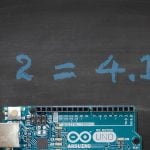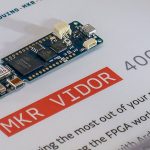This AddOhms episode is part 3 of the “design your own Arduino” series. In this one I populate a bare PCB, reflow solder it, debug a few issues, and load the Uno bootloader. Originally, I designed 2 versions of the board. One version contained an error that I planned to fix in the episode. Well, turns out, the “correct” board had two issues which were more interesting.
Check out the #27 show notes for links to a bunch of stuff in the episode, including the design files.
Watch on YouTube




3 Comments
James,
Thanks for the episode, it really gives me hope that maybe I can debug my own PCB from oshpark and try to figure out the problems I’m having. But… I don’t have a ‘scope. Care to send me one? Or can you recommend a cheap one that would be useful for basic debugging by a total hacker who only plays with this?
Another question, how did you design the stencil for your board and disk oshpark make it as well? My board was only 1″ in diameter so I got three of them for $6, which was a fabulous price. I can imagine that your board was more like $15-20 for three boards, plus stencil costs.
So the real question is, how hard is it to put on the paste without a stencil? What are the tricks to doing so, especially if you don’t have any of the reflow gear? My first ever board I just did it all by hand with solder on the pads and then I placed and soldered each part by hand. Except for those that went flying and got lost. What a pain! Those small resistors and such are damn annoying when they fly away.
Thanks again,
John
I’d recommend the PicoScope 2204. It is a 10 MHz USB-based scope for less than $150 with probes. The hardware includes a function generator but is very bare bones. The software, however, is fully featured and has measurements found in $10k+ scopes. If you ever out-grow it, it will sell just fine on eBay. You can find my review here.
I used OSHStencils. (They have no connection to OSHpark.) They offer both polyimide and metal. For this project I wanted metal. Originally I intended to create more Pyramiduinos as giveaways for top-tier Patreon supporters. Sometimes I use my laser cutter to create polyimide stencils. It’s basically just exporting the Top-Paste layer and rastering that.
If you aren’t going to use an oven or hot plate, then I wouldn’t use solder paste. If either of those is an option, then purchase solder paste in a syringe. I use that for passive devices or transistors. For an IC like a TFQP, I would tack 1 pin on with my soldering iron and then use the “drag-and-solder” method to do the rest. However, for years, I just soldered surface mount parts on with my iron, one pad at a time. There are tons of youtube tutorials on that.
With practice, it gets much better. I went full surface mount for a few years before building the oven controller. As you get better with surface mount parts, you’ll save time by not flipping the board around for through hole. I prefer the oven method, but many people have gotten away with just a hot plate. So even if you only make a board on occasion, having something to melt the solder is worthwhile.
Hi Jim,
Thanks for all the great info! I’m enthused to keep learning more, and debugging my bad board design more. I think moving to an optoisolator design might be the better way for me. But we’ll see.
And thanks for the picoscope recommendation, I’ll look it over and see what I think.
John